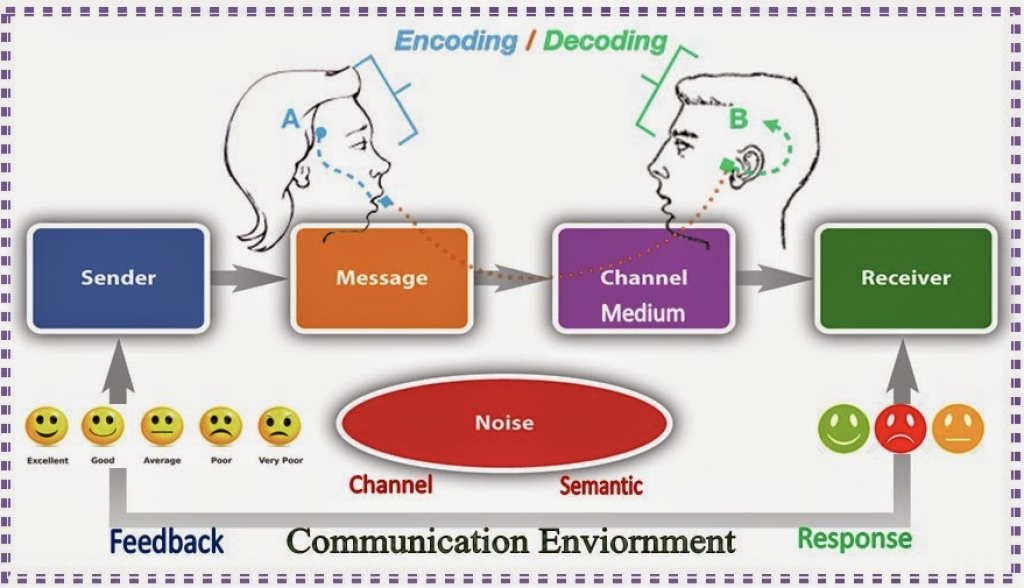 A student in my class asked a question. I said, “I’m sorry, what did you say?” She repeated her question. I walked up to her desk and said, “I’m sorry, I still didn’t hear you.”
A student in my class asked a question. I said, “I’m sorry, what did you say?” She repeated her question. I walked up to her desk and said, “I’m sorry, I still didn’t hear you.”
A student in another part of the room repeated in a loud voice what the first student had asked. The students in the room knew that I have hearing loss because it is one of the things that I tell them when I introduce myself for training. Even with the devices that assist my hearing, there are still some voices that I cannot hear and understand well.
Communication
According to Scholars Academia, communication involves the sender, the message, the channel medium, and the receiver. Noise is also a component of the communication process.

The sender is the source, message is the content of the communication, channel medium is how the message is being communicated, and receiver is the audience. If the receiver responds, the sender receives the response as feedback. Noise is anything that interferes with the communication.
As an example, the sender in my class is the student, her question was the message, and speech was the channel. I – and all of the other students in class – were receivers. For me, the noise was both my hearing loss and the literal noise, ringing in my ears (tinnitus).
My initial response was that I hadn’t heard her. For my student, this was likely negative feedback even though she was aware of my hearing loss. It is frustrating for everyone, students and instructors, when communication is interrupted. The other student’s interjection may have been a combination of frustration and empathy.
Suggestions
Everyone needs to be aware of receivers with possible hearing loss at all times. People with hearing loss do not always let you know they are experiencing it.
Here are ways to mitigate hearing challenges for your audience:
1. Project your communication so that everyone present can hear. In a large environment use a microphone. If there will be audience participation, use multiple microphones to allow the audience to respond.
2. If the audience is participating, but the main speaker is the only one with a microphone, repeat the comment or question. This may also apply during a telephone conference where there is one phone at the front of the room and multiple participants present.
3. Don’t speak too fast. I’ve observed that I don’t mentally absorb what was said as quickly as I did before I lost my hearing. Sometimes an extra 10 seconds permits me to process a comment. Additionally, professional speakers will tell you that a timely pause can make a speech more dramatic.
4. Arrange the room so that those with hearing (and seeing) issues can position themselves to best take advantage of the environment.
5. Think about whether it is appropriate to rearrange sitting positions to engage a class. I attended a training session once where the instructor reassigned people to groups every 30 or 40 minutes for the purpose of engagement. The group I was in was at the back of the room for several sessions.
6. Provide separate rooms for group breakout sessions. If I’m assigned to a breakout group and we have four or five groups in the same space, distinguishing what is being said by the speaker in my group is challenging as there is lots of noise.
7. Provide captioning to track as much of the communication as possible. In social and learning situations there are times when the communication is rapid and contributed to by many people, which can be hard to follow for someone who is audio challenged.
I enjoy being an instructor and a student. I hope that what I have shared with you will be useful as you communicate with your audiences.
Life should be an adventure. It is for Roxy Merizalde; sometimes by choice, sometimes not.
Adventures by choice: World travel for employers: Australia, Brazil (three times) Canada, Chile, Mexico, New Zealand, and South Africa; exchange student to Ecuador in South America.
Adventures not chosen: Rare salivary gland cancer; layoffs that resulted in opportunities including a job at Yellowstone National Park; and coronavirus distancing – no disease but lots of new experiences.
Roxy works for the Texas Workforce Commission as a Training Specialist. Pre-COVID-19, she traveled throughout Texas teaching staff The Workforce Information System of Texas (TWIST). Development activities include TWIST, WIT and SharePoint courses and online versions for TWIST.





Leave a Reply
You must be logged in to post a comment.